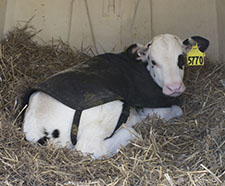 Many factors go into creating an environment that supports good calf health. There's sufficient space, proper ventilation, the ability to clean and sanitize, and adequate bedding, especially during cold weather. Another key feature that often goes unmentioned is the surface below the bedding.
Many factors go into creating an environment that supports good calf health. There's sufficient space, proper ventilation, the ability to clean and sanitize, and adequate bedding, especially during cold weather. Another key feature that often goes unmentioned is the surface below the bedding.In his presentation at the Dairy Calf and Heifer Association's Annual Conference, Ken Nordlund, D.V.M., Emeritus Professor with the University
of Wisconsin School of Veterinary Medicine, took some time to talk about what lies beneath our calves.
A typical base for calf hutches or pens is concrete, shavings and then straw. While the intentions are good, Nordlund explained that the sawdust tends to "suck up moisture, and then it stays there."
In a study conducted by his clinical group a few years ago, average bedding moisture levels came in at 52 percent. "That's an issue," said Nordlund. "We want to get a drier base to prevent thermal stress."
To maintain a deeply bedded surface, it is critical that the pen has good drainage so that urine, spilled milk and water can move out of the pen rather than soaking up in the bedding. According to Nordlund, the ideal base is 1.5 feet of gravel, with a 4-inch drain tile in place to carry out liquids. Some sort of bedding would cover this base, with deep-bedded straw being the best option, especially during the winter months.
He recommends farms remove a small amount of gravel each time the straw is cleaned out. The entire base should be replaced every one to three years.
A pen or hutch that drains properly not only keeps calves drier; it saves on bedding. Some farms have reported a 50 to 60 percent reduction in straw use when proper drainage was taking place, Nordlund shared.
If the floor beneath your calves must be solid concrete, Nordlund offered three bits of advice on how to still improve drainage. First off, the floor must be sloped to move fluids out of the pen as efficiently as possible.
Second, the fluids must move out of the pen but not into the walkways. "We don't want it in the service alley for workers to track around, either," Nordlund advised.
Lastly, the floor needs to be sloped in a way that prevents water used in the service alley from draining back into the pens and bedding. This can be accomplished by creating a crowned central work alley with a gutter placed directly in front of the calf pens. Drainage gutters should be designed to carry liquids to collection points outside the building.

The author is an associate editor and covers animal health, dairy housing and equipment, and nutrient management. She grew up on a dairy farm near Plymouth, Wis., and previously served as a University of Wisconsin agricultural extension agent. She received a master's degree from North Carolina State University and a bachelor's from University of Wisconsin-Madison.








